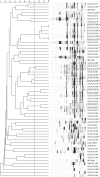Genetic and symbiotic diversity of nitrogen-fixing bacteria isolated from agricultural soils in the western Amazon by using cowpea as the trap plant
- PMID: 22798370
- PMCID: PMC3426679
- DOI: 10.1128/AEM.01303-12
Genetic and symbiotic diversity of nitrogen-fixing bacteria isolated from agricultural soils in the western Amazon by using cowpea as the trap plant
Abstract
Cowpea is a legume of great agronomic importance that establishes symbiotic relationships with nitrogen-fixing bacteria. However, little is known about the genetic and symbiotic diversity of these bacteria in distinct ecosystems. Our study evaluated the genetic diversity and symbiotic efficiencies of 119 bacterial strains isolated from agriculture soils in the western Amazon using cowpea as a trap plant. These strains were clustered into 11 cultural groups according to growth rate and pH. The 57 nonnodulating strains were predominantly fast growing and acidifying, indicating a high incidence of endophytic strains in the nodules. The other 62 strains, authenticated as nodulating bacteria, exhibited various symbiotic efficiencies, with 68% of strains promoting a significant increase in shoot dry matter of cowpea compared with the control with no inoculation and low levels of mineral nitrogen. Fifty genotypes with 70% similarity and 21 genotypes with 30% similarity were obtained through repetitive DNA sequence (BOX element)-based PCR (BOX-PCR) clustering. The 16S rRNA gene sequencing of strains representative of BOX-PCR clusters showed a predominance of bacteria from the genus Bradyrhizobium but with high species diversity. Rhizobium, Burkholderia, and Achromobacter species were also identified. These results support observations of cowpea promiscuity and demonstrate the high symbiotic and genetic diversity of rhizobia species in areas under cultivation in the western Amazon.
Figures




Similar articles
-
Insights into the Phylogeny, Nodule Function, and Biogeographic Distribution of Microsymbionts Nodulating the Orphan Kersting's Groundnut [Macrotyloma geocarpum (Harms) Marechal & Baudet] in African Soils.Appl Environ Microbiol. 2019 May 16;85(11):e00342-19. doi: 10.1128/AEM.00342-19. Print 2019 Jun 1. Appl Environ Microbiol. 2019. PMID: 30952658 Free PMC article.
-
Symbiotic functioning and bradyrhizobial biodiversity of cowpea (Vigna unguiculata L. Walp.) in Africa.BMC Microbiol. 2010 Mar 23;10:89. doi: 10.1186/1471-2180-10-89. BMC Microbiol. 2010. PMID: 20331875 Free PMC article.
-
Unveiling remarkable bacterial diversity trapped by cowpea (Vigna unguiculata) nodules inoculated with soils from indigenous lands in Central-Western Brazil.Braz J Microbiol. 2025 Mar;56(1):545-562. doi: 10.1007/s42770-025-01622-z. Epub 2025 Jan 23. Braz J Microbiol. 2025. PMID: 39847210
-
Phyllobacteriaceae: a family of ecologically and metabolically diverse bacteria with the potential for different applications.Folia Microbiol (Praha). 2024 Feb;69(1):17-32. doi: 10.1007/s12223-023-01107-2. Epub 2023 Dec 1. Folia Microbiol (Praha). 2024. PMID: 38038797 Review.
-
Characterization of symbiotic and nitrogen fixing bacteria.AMB Express. 2022 Jul 30;12(1):99. doi: 10.1186/s13568-022-01441-7. AMB Express. 2022. PMID: 35907164 Free PMC article. Review.
Cited by
-
Morphological and Genetic Diversity of Rhizobia Nodulating Cowpea (Vigna unguiculata L.) from Agricultural Soils of Lower Eastern Kenya.Int J Microbiol. 2017;2017:8684921. doi: 10.1155/2017/8684921. Epub 2017 Dec 31. Int J Microbiol. 2017. PMID: 29463983 Free PMC article.
-
The Structural and Functional Responses of Rhizosphere Bacteria to Biodegradable Microplastics in the Presence of Biofertilizers.Plants (Basel). 2024 Sep 20;13(18):2627. doi: 10.3390/plants13182627. Plants (Basel). 2024. PMID: 39339601 Free PMC article.
-
Rhizobia and endophytic bacteria isolated from rainforest fragments within an iron ore mining site of the Eastern Brazilian Amazon.Braz J Microbiol. 2021 Sep;52(3):1461-1474. doi: 10.1007/s42770-021-00524-0. Epub 2021 Jun 17. Braz J Microbiol. 2021. PMID: 34142357 Free PMC article.
-
Bradyrhizobium as the Only Rhizobial Inhabitant of Mung Bean (Vigna radiata) Nodules in Tropical Soils: A Strategy Based on Microbiome for Improving Biological Nitrogen Fixation Using Bio-Products.Front Plant Sci. 2021 Jan 12;11:602645. doi: 10.3389/fpls.2020.602645. eCollection 2020. Front Plant Sci. 2021. PMID: 33510747 Free PMC article.
-
Tripartite symbiosis of Sophora tomentosa, rhizobia and arbuscular mycorhizal fungi.Braz J Microbiol. 2017 Oct-Dec;48(4):680-688. doi: 10.1016/j.bjm.2017.03.007. Epub 2017 Jun 29. Braz J Microbiol. 2017. PMID: 28756029 Free PMC article.
References
-
- Benata H, et al. 2008. Diversity of bacteria that nodulate Prosopis juliflora in the eastern area of Morocco. Syst. Appl. Microbiol. 31:378–386 - PubMed
-
- Chagas-Junior AF, Oliveira LA, Oliveira AN. 2010. Phenotypic characterization of rhizobia strains isolated from Amazonian soils and symbiotic efficiency in cowpea. Acta Sci. Agron. 32:161–169
-
- de Lajudie P, et al. 1998. Characterization of tropical tree rhizobia and description of Mesorhizobium plurifarium sp. nov. Int. J. Syst. Bact. 48:369–382 - PubMed
-
- Florentino LA, Sousa PM, Silva JS, Silva KB, Moreira FMS. 2010. Diversity and efficiency of Bradyrhizobium strains isolated from soil samples collected from around Sesbania virgata roots using cowpea as trap species. Rev. Bras. Cienc. Solo 34:1113–1123
-
- Fred EB, Waksman SA. 1928. Laboratory manual of general microbiology, p 33 McGraw-Hill, New York, NY
Publication types
MeSH terms
Substances
Associated data
- Actions
- Actions
- Actions
- Actions
- Actions
- Actions
- Actions
- Actions
- Actions
- Actions
- Actions
- Actions
- Actions
- Actions
- Actions
- Actions
- Actions
- Actions
- Actions
- Actions
- Actions
- Actions
- Actions
LinkOut - more resources
Full Text Sources
Molecular Biology Databases

